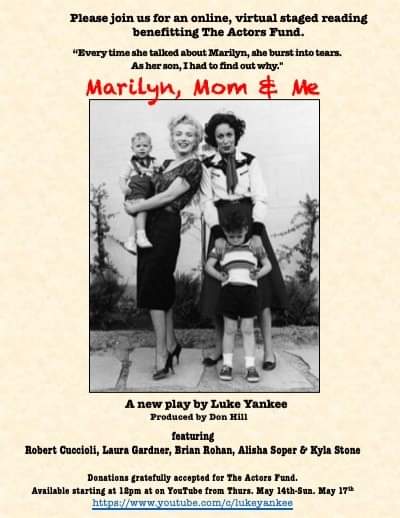
A staged reading of Marilyn, Mom & Me – Luke Yankee’s play about his late mother, actress Eileen Heckart’s friendship with Marilyn during filming of Bus Stop – will be available to stream later today on YouTube, through to Sunday.
Marilyn Monroe 1926-1962

A staged reading of Marilyn, Mom & Me – Luke Yankee’s play about his late mother, actress Eileen Heckart’s friendship with Marilyn during filming of Bus Stop – will be available to stream later today on YouTube, through to Sunday.

Fashion designer Agnès B has assembled a group of creatives to put different spins on her classic black ‘snap cardigan’ for a new exhibition, opening in Manhattan this weekend and on display until March 1st, Flaunt reports. Among them is photographer William Strobeck, who has put the cardigan on a lifesize cutout of Marilyn in Bus Stop. A Monroe fan herself, Agnès B has said she was touched by the simple elegance of Marilyn’s possessions during a private view of The Personal Property of MM at Christie’s in 1999.

Gene London, the television personality turned fashion designer who owned one of the world’s largest Hollywood costume collections, has died aged 88. Born Eugene Yulish in Cleveland, Ohio, he presented a children’s television programme on WCAU Channel 10 in Philadelphia from 1959-77.
When the show was cancelled, Gene moved to New York and started a second career as a dress designer, opening a retro boutique, ‘Gene London: The Fan Club’ on West 19th Street in Manhattan. He also worked as a fashion consultant in film, television and theatre, and as a spokesman for Mikimoto jewellery.
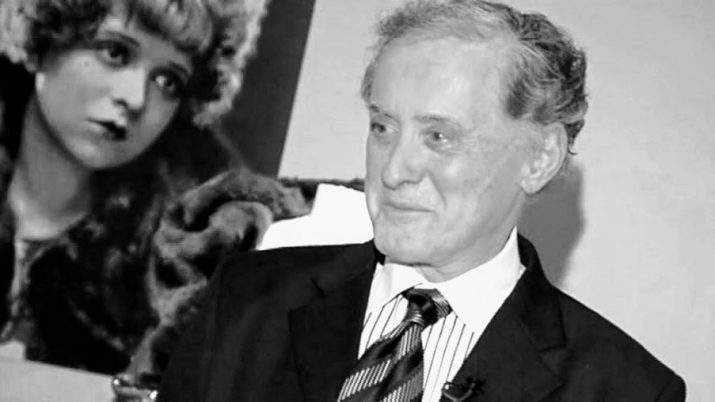
After closing his store in 2001, Gene unveiled over fifty costumes from classic movies which he had collected as a hobby and would showcase in exhibitions over the coming years.
In 2011, Gene appeared on Four Rooms, a UK television show about auctions and collectibles, presenting ‘Myself, Exercising’, an original watercolour by Marilyn Monroe. He was offered £150,000 for the painting, but turned it down.

Gene also owned this photo-booth image of a 13-year-old Norma Jeane, which she had sent with a letter to her older half-sister, Berniece Baker Miracle.
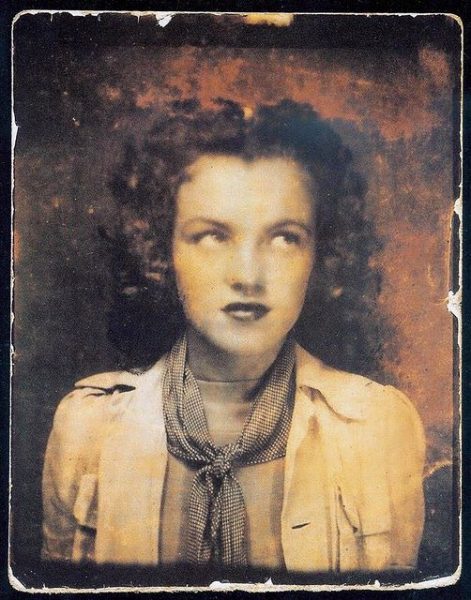
A year later, Gene attended a screening of the biopic My Week With Marilyn, showing filmgoers the original dress worn by Monroe in The Prince and the Showgirl (one of four copies.)
“‘You can see by this dress that Marilyn’s figure was ample,’ said London pointing to the white gown. ‘She’s very curvy which was the style then, no longer the style now.’
London said he had his eye on this dress when he was buying other costumes from a man in Wisconsin.
‘The one thing he wouldn’t give me was this dress,’ said London, ‘I wanted it the most of all of them. He said nope, that’s going to my children.’
But London said the grandchild called 25 years later.
‘I adored the way she acted,’ said London about Monroe. ‘I adore the way she sang “Diamonds are a Girl’s Best Friend.” I just love her. It’s hard to explain why. I just do.'”
ES Updates
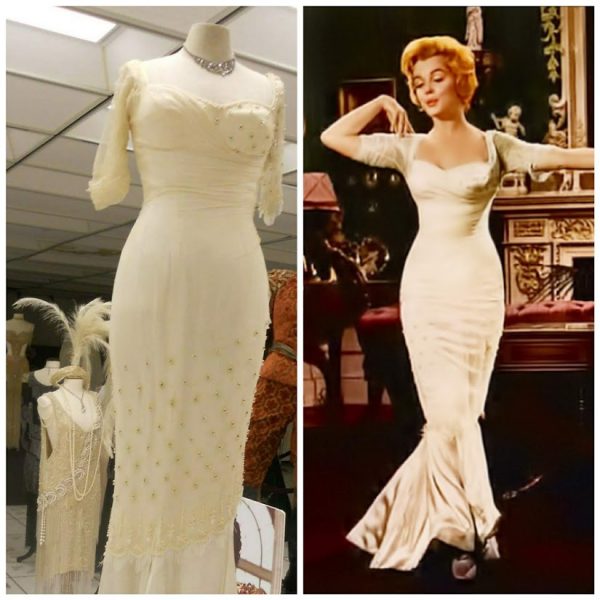
The green blouse and black pencil skirt worn by Marilyn in Bus Stop were featured in Designing Hollywood, an exhibition at the Allentown Museum of Art in 2019.
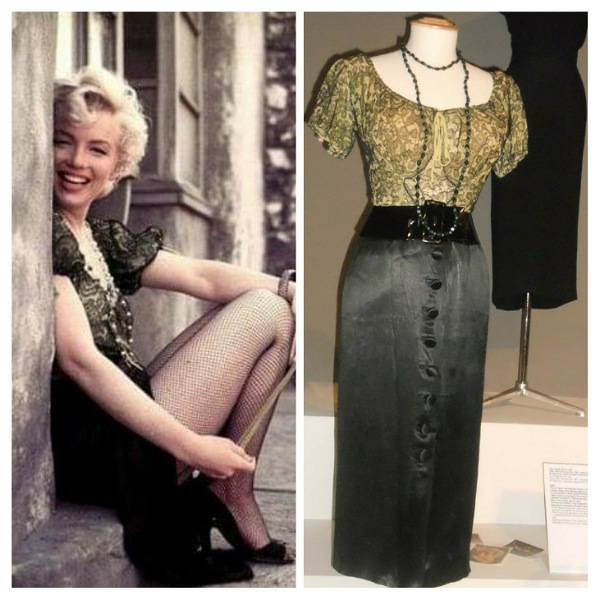
Among the other items in Gene’s collection were an orange camisole worn by Marilyn in a 1953 glamour shoot.
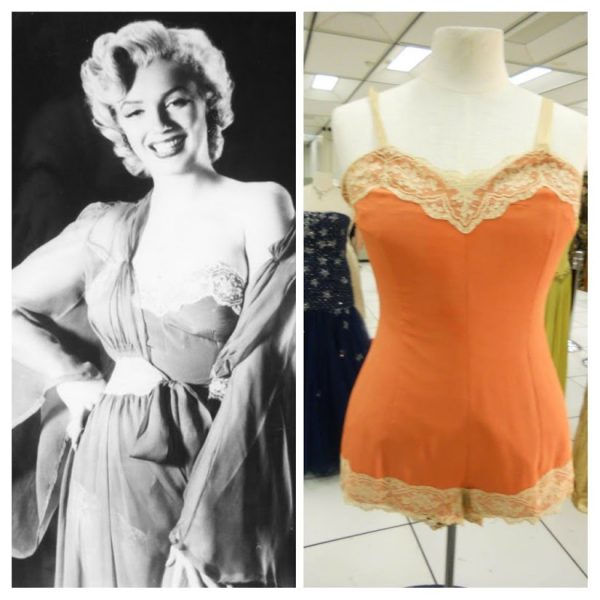
Gene London died suddenly after a fall at his home in Reading, Pennsylvania on January 19, 2020. He is survived by husband John Thomas, and will be buried alongside his parents in Cleveland.
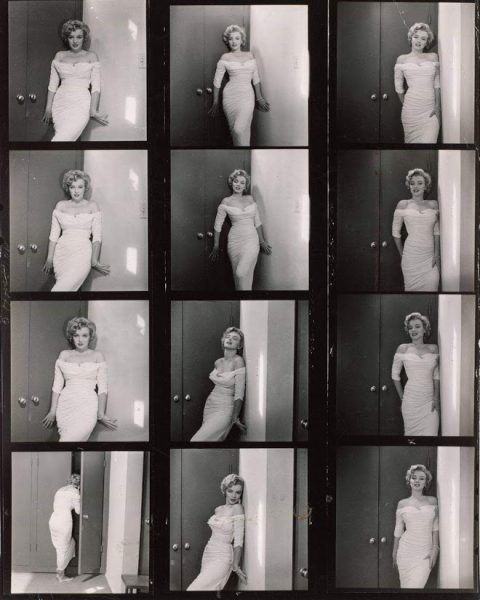
PROOF: Photography in the Era of the Contact Sheet, on display at the Cleveland Museum of Art from February 2 – April 12, includes a section devoted to Marilyn and is accompanied by Marilyn X 4, a week-long film series with screenings of Gentlemen Prefer Blondes, Some Like It Hot, Bus Stop and The Misfits (from February 9-16.)
Thanks to Catherine at Marilyn Remembered

The Utah Theatre in Logan is devoting this month to Marilyn, with screenings of The Misfits this week, followed by Bus Stop from next Wednesday, and The Seven Year Itch, Gentlemen Prefer Blondes and There’s No Business Like Show Business afterwards.
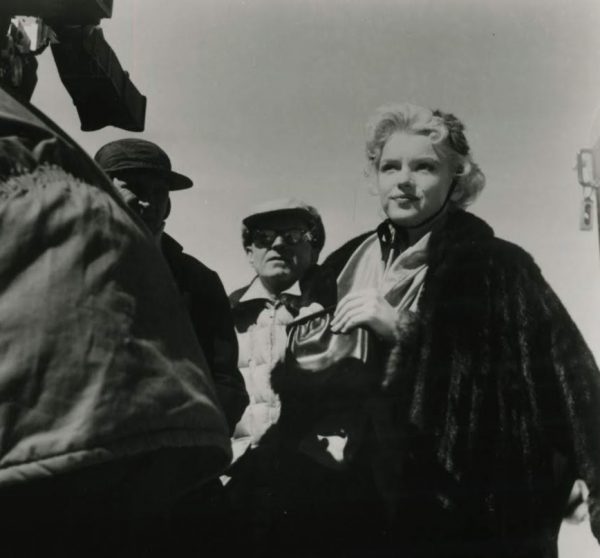
Bus Stop is one of my favourite Monroe films: an evocative character piece with an outstanding performance from Marilyn. However, many now find its gender politics – and Bo’s manhandling of Cherie – outdated and sexist. On the Culled Culture blog today, Genna Rivieccio considers why Bus Stop ‘didn’t do justice to how Marilyn Monroe fought to break free of the studio’s stereotype of her.’ (In her recent book, Some Kind of Mirror, Amanda Konkle takes a more positive view, noting that Cherie resists Bo’s advances until he learns to satisfy her desires.)
“Marilyn Monroe had spent months waiting out her unprecedented studio battle with 20th Century Fox. After fleeing to New York from Los Angeles like some sort of blonde haloed fugitive, Marilyn refused to ever turn back. To ever succumb to any of the dumb sexpot roles Darryl Zanuck wanted her to make in perpetuity. Yet the choice of ‘Chérie’–ultimately pronounced Cherry by the one who ‘wrangles’ her–in William Inge’s play, Bus Stop, didn’t seem to do much to distance herself from the image she so strongly claimed to detest. But maybe a part of her was terrified to shed it completely. For the thought of losing her adoring fans–the only source of true love in her life–was likely just as scary as forever being typecast. So it is that she went with the “just daring enough” role of Chérie … there is a meta tongue-in-cheek moment in which Chérie talks about her big plan to make it to Hollywood where ‘you get treated with a little respect.’ It’s an overt dig at Zanuck and 20th Century Fox (which Marilyn famously called 19th Century Fox for its backward treatment of female stars) …
Yet like Chérie, she can’t help but look to men for salvation. The two prototypes that would be her most tumultuous romances (and marriages), Joe DiMaggio and Arthur Miller, are both apparent in Beau. Outwardly, his rough-hewn tactlessness makes him a closer match to DiMaggio … Upon learning of her ‘sordid’ past (a.k.a. that she’s been with a few men to further accent the fact that Beau hasn’t–Miller, too, was rather virginal, having only ever been with his first wife before Marilyn), Beau finds the key to unlocking her heart by telling her, ‘Well, I’ve been thinkin’ about them other fellas, Cherry, and, well, what I mean is, I like you the way you are, so what do I care how you got that way?’ Miller told her pretty much the same thing, never chastising her the way DiMaggio did for parading her sexy persona, which is a primary reason why she fell in love with him …
Once again in this film (as in life), Monroe is a little girl lost, who is put back on the right path by a male savior. This was not a departure by any means from what she had done in the past with the studio, and made one wonder how the accolades came in so readily for a movie such as this, when past roles in Clash By Night, Don’t Bother to Knock and Niagara provided her far more opportunity for dramatic range.
Bus Stop is still billed as somewhere in between a comedy and drama, though it very much falls into an almost screwball comedy genre (for that’s kind of how one has to look at a movie so overtly dripping with misogyny and the suppression of the female will). Marilyn would only make four more movies after this, among them being one of the most praised of her career, Some Like It Hot (with another two, The Prince and the Showgirl and Let’s Make Love, being largely panned), a film in which, you guessed it, Marilyn relies on the comedic sex symbol shtick that launched her into the spotlight in the first place.”
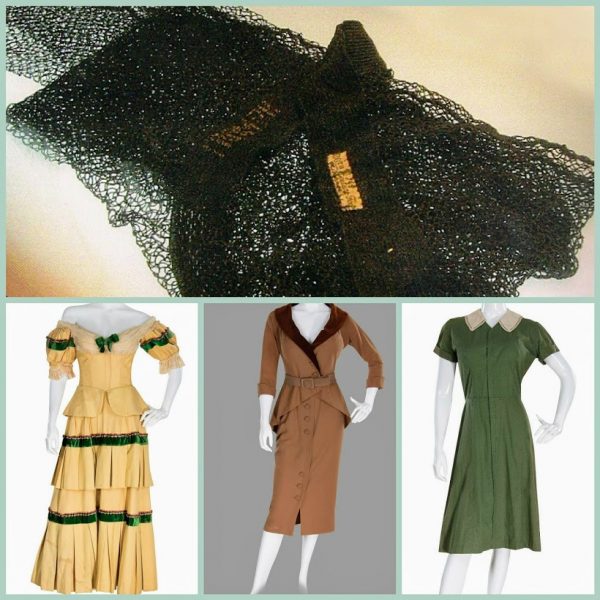
Over 50 Marilyn-related lots will go under the hammer at on December 17-19, as part of the Hollywood – A Collector’s Ransom auction at Profiles in History. Marilyn’s costumes from A Ticket to Tomahawk, Love Nest, and Don’t Bother to Knock, and her fishnet tights from Bus Stop – which went unsold at last year’s Essentially Marilyn event – are back for a second chance. (UPDATE: the brown skirt suit worn by Marilyn in Love Nest has been sold for $30,000 – but again, the other movie costumes went unsold.)
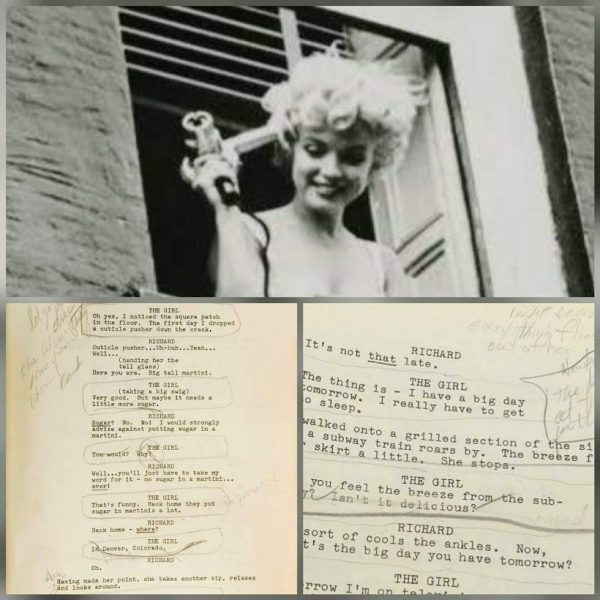
As Simon Lindley reports for Just Collecting, Marilyn’s personal annotated screenplay for The Seven Year Itch is also on offer, with a reserve of $60-80K. (The photo shown above, taken on location in New York, is sold separately.)
“In the film Monroe’s character is known simply as ‘The Girl’, an aspiring actress who serves as the object of the husband’s desires.
But behind her on-screen persona as the blonde sex symbol, Monroe’s extensive handwritten annotations reveal her dedication to her craft.
Throughout the script she has written notes to herself such as ‘Look first indecisive – pause – hesitation – little smile’ and ‘My body into his – sliding into him as if I want to sleep with him right then & there. Swing hips again’.
This preparation and complete understanding of the role in evident in her notes for the famous ‘Subway’ scene, which helped cement her place as a genuine Hollywood icon.
The energy and sexuality which Monroe portrays may seem effortless, but her script notes show she though very carefully about how to play the moment: ‘Child w/a woman. Direct & fem[inine]. Open… This is everything there is in the world. Light & easy. Everything flies out of her. Newborn – the baby looking at the moon for the first time.'”
Screenplay UNSOLD; photo sold for $200
And now, let’s take a closer look at what else is on offer…
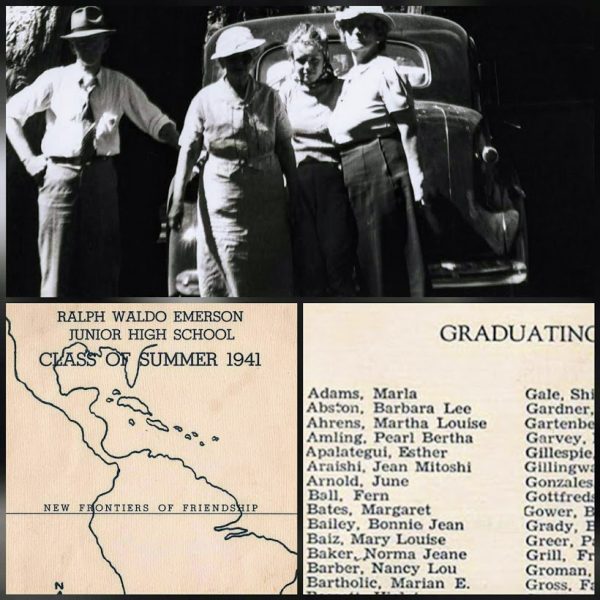
“Vintage original 8 x 10 in. photograph taken of 13 year-old Norma Jeane on a trip to Yosemite with ‘Aunt’ Ana Lower and other family members. And sold separately, a vintage original 2-page printed 6.25 x 9 in. Ralph Waldo Emerson Junior High School Class of Summer 1941 commencement program. The printed program contains itinerary including music, speeches, and songs. Listed alphabetically in the ‘Graduating Class, June 1941 Girls’ roster of graduates is ‘Baker, Norma Jeane’.”
UNSOLD
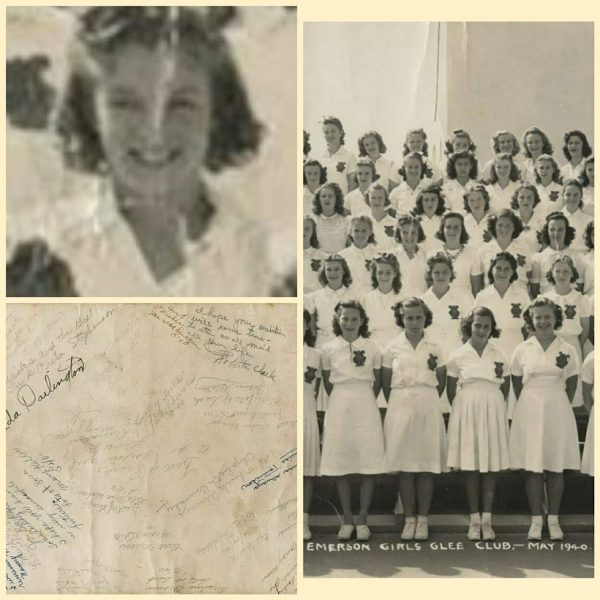
“Vintage original gelatin silver 8 x 10 in. photograph of Marilyn with her junior high school glee club, smiling in the center of the group. The verso is copiously inscribed with messages to Norma Jeane by her girlfriends, including, ‘To a beautiful, sweet, charming, and darling, adorable Norma Jean’ and ‘I hope your ambition will come true – to stay an old maid all your life’.”
SOLD for $3,000

“A 2-page letter to ‘Cathy’ handwritten in pencil and signed, ‘Norma Jeane’. Written during a period of major transition in her life, Norma Jeane mentions a leave of absence from her job as a parachute inspector at Radioplane. She had recently been ‘discovered’ by US Army Air Force First Motion Picture Unit photographer David Conover while working at the plant, and through his connections, had been able to get freelance work as a pin-up model. She writes in full: ‘Thursday. My dearest Cathy, thank you for your sweet little note, why of course of course I like you dear very much, you know that. If I seem a little neglectful at times its because I’m so busy I don’t seem to have any time to catch up on my correspondence, but I promise after this, I shall, do better, honestly I will. Jimmie arrived about three weeks ago and you can imagine how thrilled I was. I only wish he didn’t have to go back. Jimmie and I went up to Big Bear Lake for a week and had a grand time I hope you and Bud will be down soon because I would love for you both to meet him. I’ve been on leave of absence from Radioplane. I shall tell you all about it when I see you honey or I shall write to you later. I have so many things I have to do so I had better close for now but I shall write soon. Tell Bud Hello for me. Love, Norma Jeane.'”
UNSOLD

Vintage original 8 x 10 in. cast & crew photo from Marilyn’s first movie, Scudda Hoo! Scudda Hay! She is in the third row, just above leading lady June Haver. SOLD for $1,500
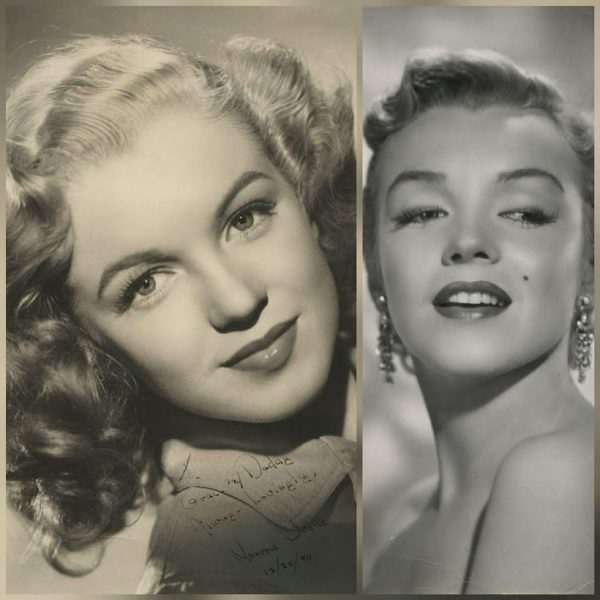
“Vintage original gelatin silver 7 x 8.75 in. double weight matte photograph, inscribed and signed in black ink at lower right, ‘To Grace and Daddy Always Lovingly Norma Jeane 12/25/46′. The ‘daddy’ to whom Norma Jeanne inscribed this early headshot is Erwin ‘Doc’ Goddard, a research engineer and the husband of Norma Jeanne’s legal guardian, Grace Goddard. And sold separately, two oversize glamour portrait photographs of Marilyn Monroe in character as ‘Miss Caswell’ in All About Eve. The first is credit stamped by Ray Nolan with studio snipe, and the other, seen at right, attributed to Ed Clark.” [A poster for the film, signed by Bette Davis, Joseph Mankiewicz, and Celeste Holm, is being sold separately.]
Signed photo SOLD for $30,000; poster SOLD for $6,000.

Two vintage calendars including a 1950 wall calendar measuring 8.5 x 14.5 in., and featuring paintings by Earl Moran, six featuring Marilyn, alongside cute, risque poems like, ‘What are little girls made of? Sugar and spice, Perfume that smells nice, Jewels and furs, To attract attention, And other good things Too obvious to mention’, and a wall calendar featuring unique topless ‘cowgirl’ images of Marilyn not seen elsewhere. Sold separately, a 16 x 32 in. pin-up 1952 wall calendar titled, ‘The Lure of Lace‘. Featuring Marilyn Monroe in her famous Tom Kelley nude kneeling pose, but with a black lace teddy ‘overprint’.”
UNSOLD
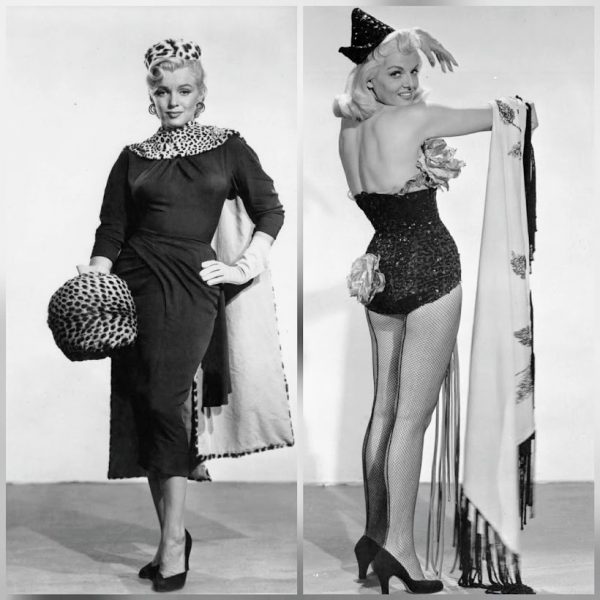
“Two original studio production 8 x 10 in. negatives of Marilyn Monroe and Jane Russell in Gentlemen Prefer Blondes, each modeling wardrobe by designer William Travilla. [Russell wore a blonde wig to impersonate Marilyn in a courtroom scene.] Each includes within image a ‘shot-board’ documentation of production, scene, and change numbers. Also included are two original wardrobe documentation green pages detailing costumes [Monroe page describes a different costume, for the opening ‘Little Rock’ number.] At some point in time a positive copy print of the Monroe negative was made for archive continuity, but is not original to the production.”
UNSOLD
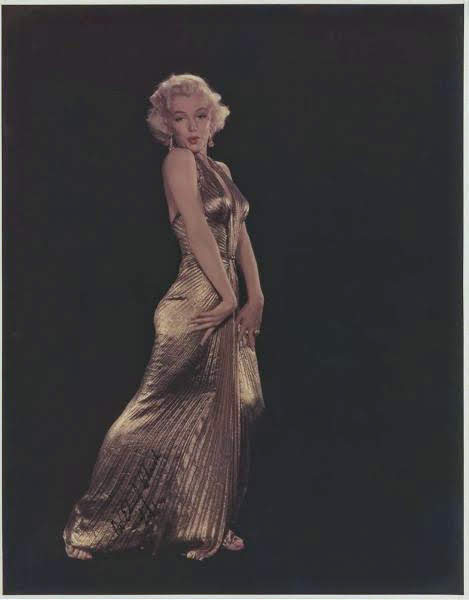
“11 x 14 in. portrait by Ed Clark of Marilyn in the gold lame gown from Gentlemen Prefer Blondes for LIFE magazine. Signed in black ink on Marilyn’s skirt by the photographer, ‘Edmund Clark Life’.”
SOLD for $300
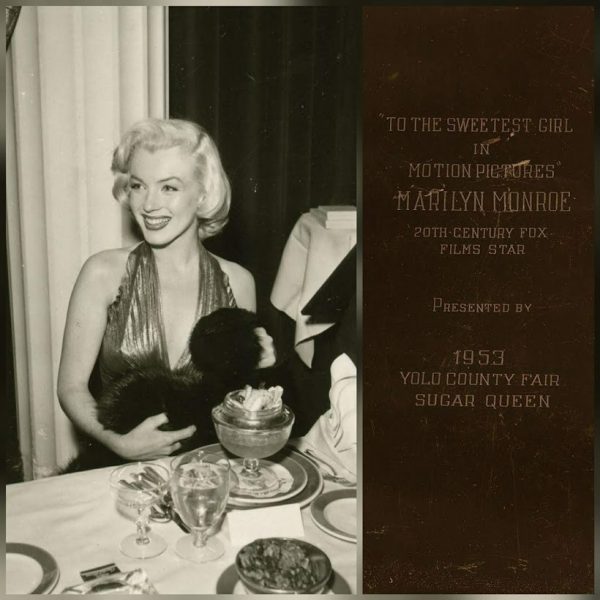
“Photo of Marilyn at the Photoplay Awards in 1953, part of a 1750-image archive for celebrity snapper J.B. Scott. And sold separately, an award plaque presented to Marilyn by a County Fair ‘Sugar Queen’, engraved, ‘To the Sweetest Girl in Motion Pictures, Marilyn Monroe, 20th Century-Fox Films Star Presented by 1953 Yolo County Fair Sugar Queen’.”
Photo archive SOLD for $95,000; award plaque UNSOLD.
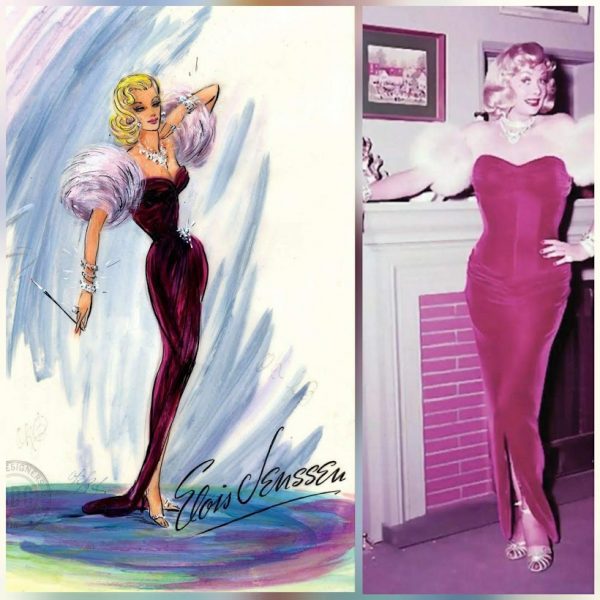
“Elois Jenssen costume sketch for Lucille Ball as ‘Lucy Ricardo’ as ‘Marilyn Monroe’ from I Love Lucy. Elois Jenssen was Lucille Ball’s designer of choice, who is credited with creating the ‘Lucy Look’. This dress design was created for the I Love Lucy Episode: ‘Ricky’s Movie Offer’, which aired on Nov. 8th, 1954. In the episode, ‘Lucy’ transforms herself into Marilyn Monroe to try to win a role in Ricky’s (Desi Arnaz) new Hollywood film. This costume was then repurposed into a showgirl costume for two subsequent episodes.” [Elois Jenssen’s costume sketches for Marilyn in We’re Not Married are being sold separately.]
UNSOLD
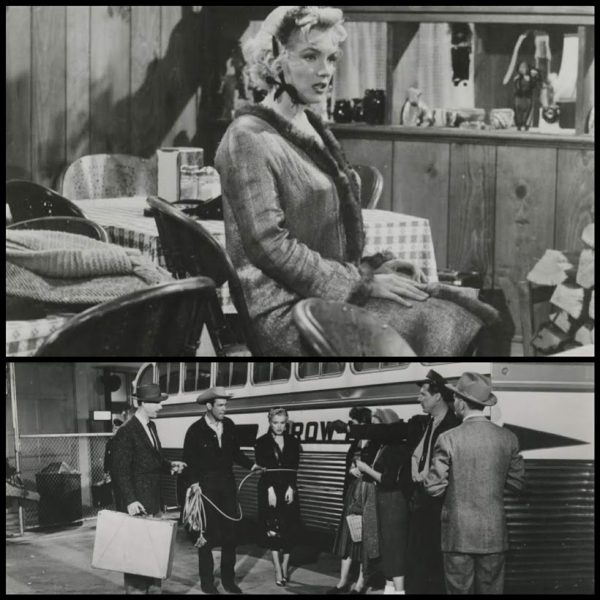
“Ten 8 x 10 in. photographs of Marilyn Monroe in scenes from films, including the earliest title which depicts her on any of its publicity, Dangerous Years. Other highlights include Ladies of the Chorus, The Asphalt Jungle, Right Cross [to our knowledge, this still is the only original release paper to depict Marilyn], Let’s Make it Legal, and [shown above] Bus Stop.
SOLD for $225
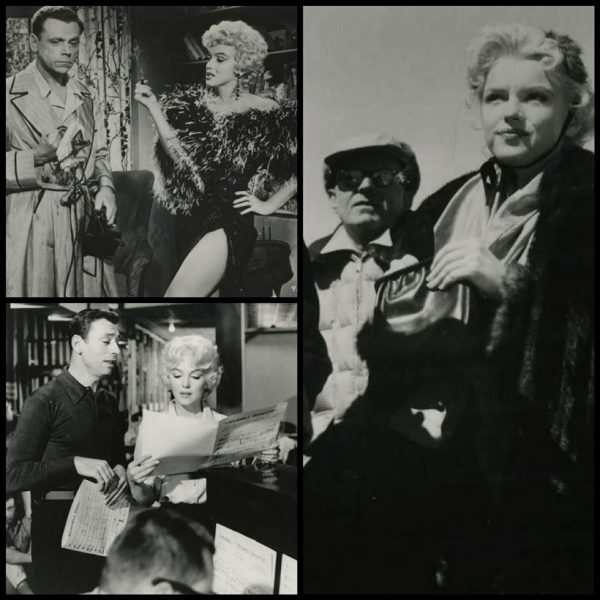
“A set of fourteen 7 x 8.5 in. to 8 x 10 in. photographs, a mix of portraits, candids, and scenes, including stills from The Seven Year Itch and Let’s Make Love [at left] and a candid by Al Brack [at right], showing Marilyn on location for Bus Stop in Sun Valley, Idaho.”
UNSOLD
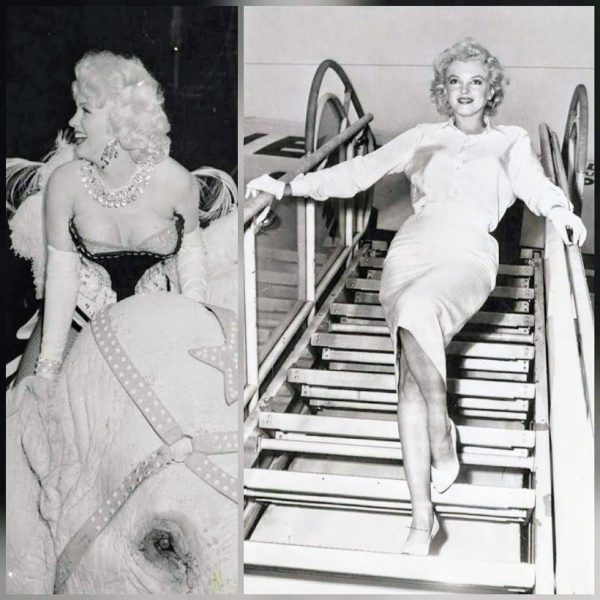
“Two exhibition photos signed by Marvin Scott, of Marilyn performing at a circus benefit in 1955; and sold separately, another set including this photo of Marilyn arriving at Los Angeles in 1958 for the filming of Some Like It Hot.
UNSOLD
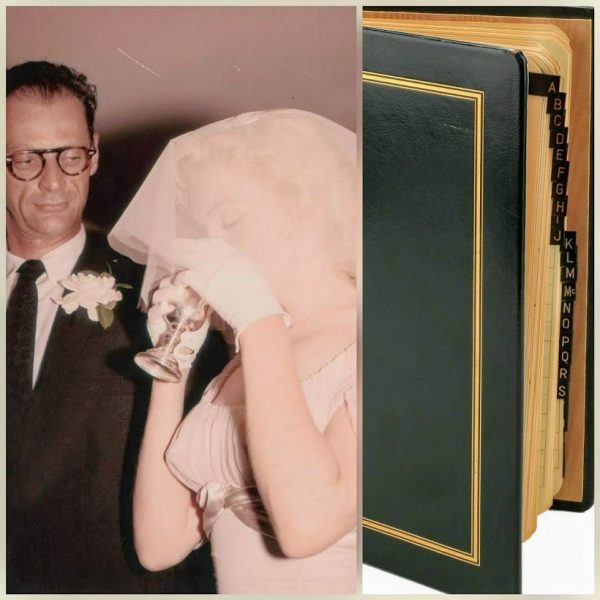
“A candid photo taken by Milton Greene at Marilyn’s wedding to Arthur Miller; and sold separately, two address books from her estate, including typed and annotated entries for contacts including Actor’s Studio, Jack Benny, Eve Arden, George Cukor, Montgomery Clift, Jack Cardiff, Joe DiMaggio, Henry Fonda, John Huston, Hedda Hopper, Designers, makeup artists, Ben Gazzara, Gene Kelly, Jack Lemmon, Yves Montand, Arthur Miller, Robert Montgomery, Jane Russell, Jean Negulesco, Lee and Paula Strasberg, David Selznick, Carl Sandburg, Frank Sinatra, Eli Wallach, Shelley Winters, Clifford Odets, Peter Lawford, JAX, Richard Avedon, Louella Parsons, and more. Annotations not attributed to Monroe.”
UNSOLD

And finally, a set of nine photos from Marilyn’s last completed film, The Misfits (1961.) SOLD for $4,500
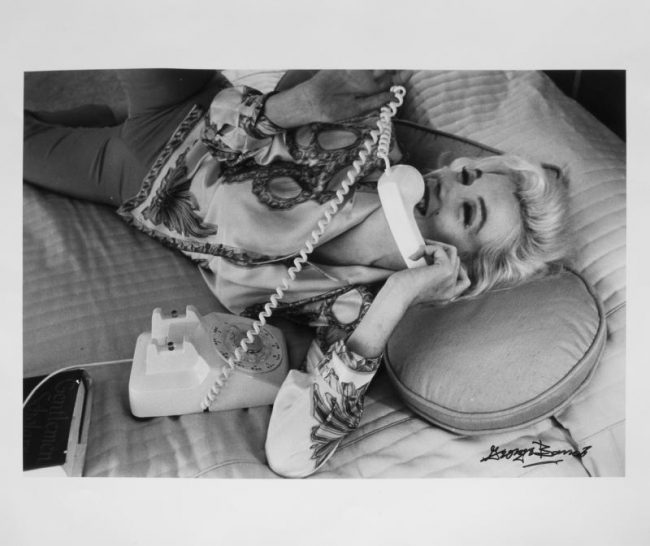
When perusing Marilyn’s personal correspondence and keepsakes, what always impresses me is that for all her self-doubt, there were so many people in her life whom she cherished, and they adored her in return. And this is evident in the lots going under the hammer in Property From The Life and Career of Marilyn Monroe at Julien’s Auctions on November 1. (You can read all my posts on the sale here.)

“A Bank of America check written entirely in Marilyn Monroe’s hand in blue ink dated January 1, 1952, made payable to N. Lytess in the amount of $100.00. ‘N. Lytess’ is Natasha Lytess, Monroe’s acting coach from 1948 until 1955.”
SOLD for $2,560
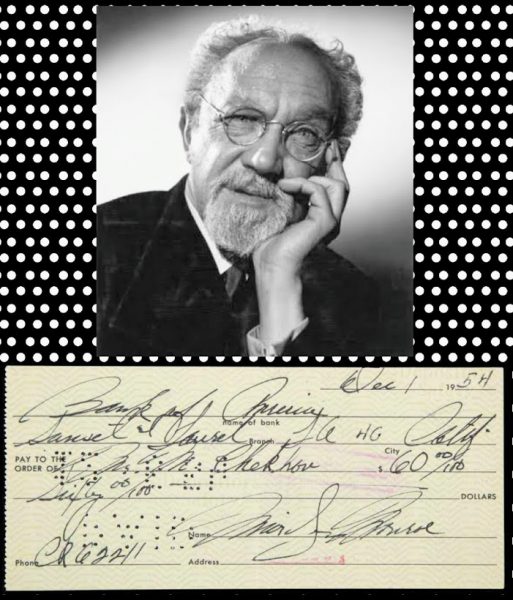
“A standard handwritten check entirely penned in black fountain pen ink by the star, dated ‘Dec 1 54,’ written out to ‘Mr. M. Chekhov’ [Michael Chekhov, her acting coach] for ‘$60’ and signed in the lower right corner ‘Marilyn Monroe,’ cancellation stamps and punch-outs evident on verso.”
SOLD for $3,520
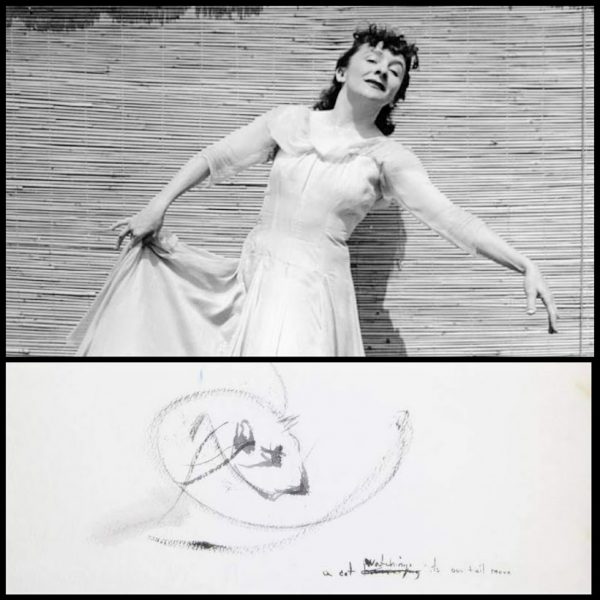
“A watercolour painting rendered on construction paper by Marilyn herself depicting an abstract image of a cat in shades of black and gray, further inscribed by Monroe on the lower right side ‘a cat watching its own tail move’; included with a photocopied letter dated ‘March 5th, 1999’ reading in part ‘(this) painting / was found among Lotte Goslar’s personal files…Lotte and Marilyn were close / friends’ — Goslar being a German choreographer who worked in Hollywood and who had occasion to meet and work with Monroe.”
SOLD for $5,120
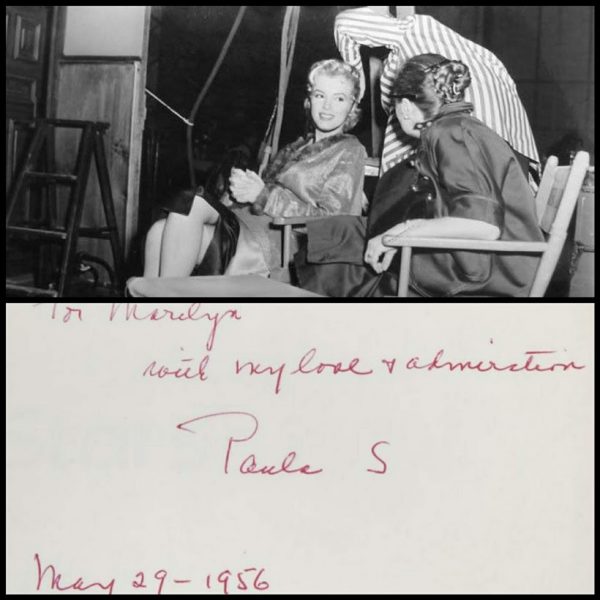
“A Paula Strasberg gifted and inscribed copy of Great Stars of the American Stage, with inscription reading ‘For Marilyn/With my love and admiration/ Paula S/ May 29-1956.’ Interestingly, this was the date of Marilyn Monroe’s completion of filming for Bus Stop.”
SOLD for $1,125
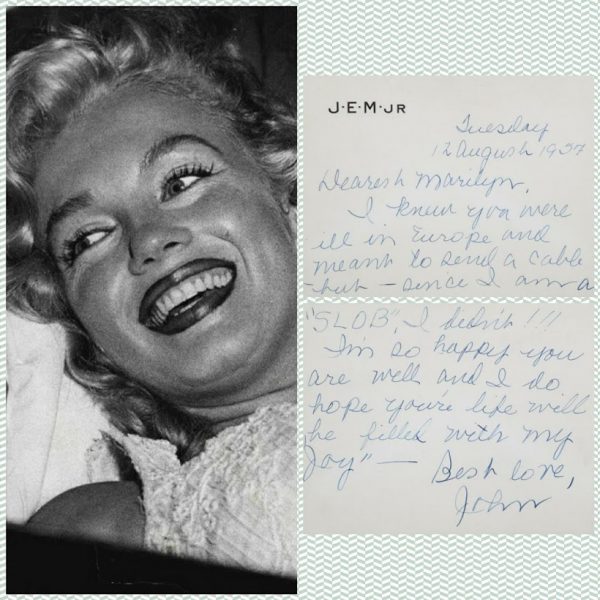
“A handwritten note from John Moore, one of Marilyn Monroe’s favorite designers [sent shortly after Marilyn’s hospitalisation for an ectopic pregnancy.] The August 12, 1957, note reads, ‘Dearest Marilyn, I knew you were ill in Europe and meant to send a cable – but – since I am a SLOB, I didn’t!!! I’m so happy you are well and I do hope your life will be filled with my Joy.’ Best love, John.”
SOLD for $100
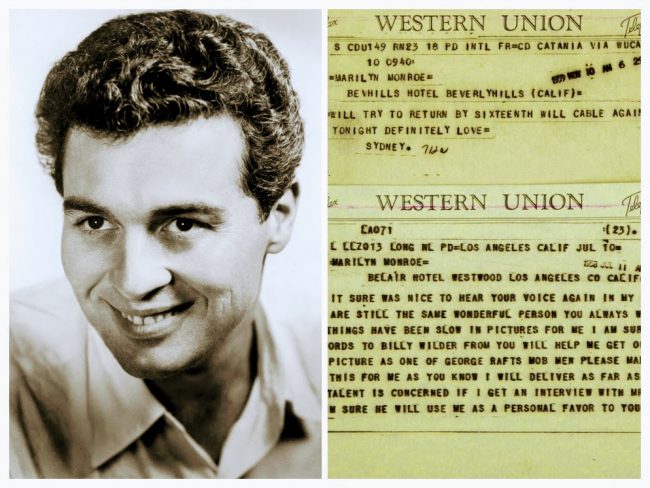
The “A two-page telegram to Marilyn Monroe from Tony Award winning actor Sydney Chaplin [her friend since the late 1940s.] The July 11, 1958, telegram reads, ‘It sure was nice to hear your voice again/ In my book you are still the same wonderful person you always were/ Things have been slow in pictures for me/ I am sure a few words to Billy Wilder from you will help me get on the picture as one of George Raft’s mob men/ Please Marilyn do this for me as you know I will deliver as far as my talent is concerned/ If I get an interview with Mr. Wilder I’m sure he will use me as a personal favor to you/ Many will try to return by sixteenth/ Will cable again tonight definitely/ Love Sydney.'”
SOLD for $256
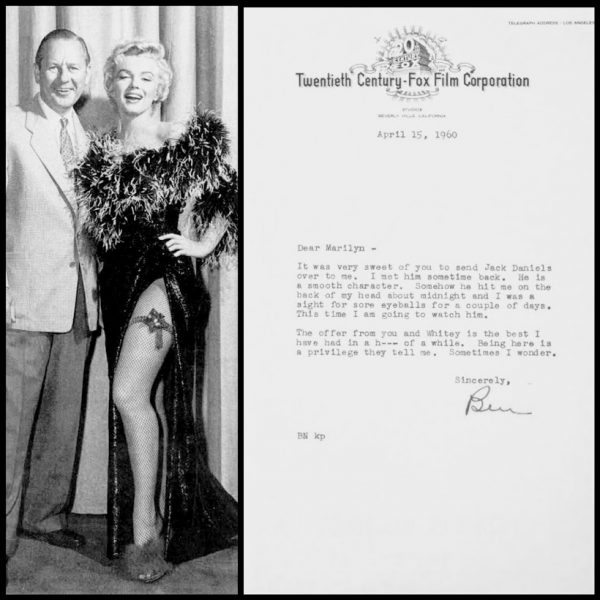
“A one-page typed letter on Twentieth Century-Fox Film Corporation letterhead to Marilyn Monroe from studio executive Ben Lyon. The April 15, 1960, letter reads, ‘Dear Marilyn, It was very sweet of you to send Jack Daniels over to me. I met him sometime back. He is a smooth character. Somehow he hit me on the back of my head about midnight and I was a sight for sore eyeballs for a couple of days. This time I am going to watch him. The offer from you and Whitey [Snyder] is the best I have had in a h— of a while. Being here is a privilege they tell me. Sometimes I wonder.’ The letter is signed ‘Sincerely, Ben.’ Monroe has acknowledged that Lyon was responsible for helping her select the name ‘Marilyn Monroe’ and for giving her her first break.”
SOLD for $256

“A three-page handwritten letter to Marilyn Monroe from poet and friend Norman Rosten, written while Rosten was in court for jury duty. The May 2, 1960, letter reads in part, ‘This is just to tell you my reaction to the house in the country. Everything looks wonderful – the work on the inside of the house but especially the outside, I meant the new trees. They are not out in full leaf yet but will be soon, and then they will be stunning. I love the single tree in the back, it’s placed exactly right.’ Rosten goes on to say that Arthur [Miller] was a good host, and ‘he did everything except bake a cake’ and ‘I assume he does that for you.’ Included is a separate piece of paper with a previously affixed newspaper clipping of the story of a man hitting ‘the only tree within 1,000 miles.’ Handwritten by Rosten on the paper is this: ‘So you think you have had tree troubles in Roxbury!’ Included is the original envelope addressed to Monroe at the Beverly Hills Hotel in California.”
SOLD for $512
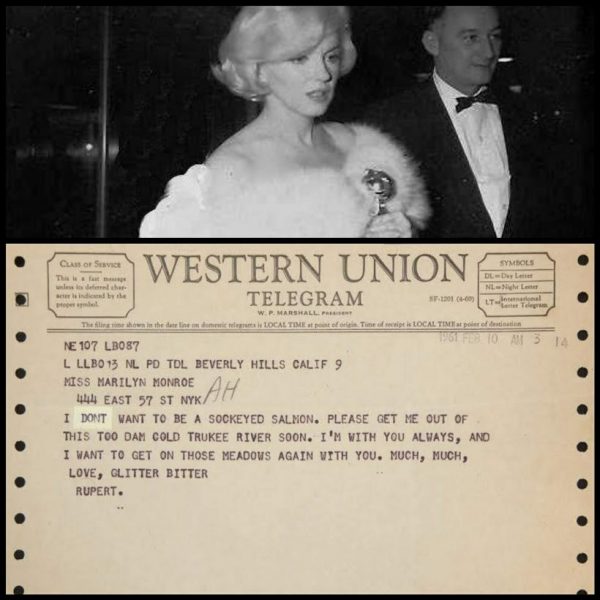
“A telegram from Rupert Allan to Marilyn Monroe, dated February 10, 1961. The telegram reads, ‘I don’t want to be a sockeyed salmon/ Please get me out of this too dam [sic] cold Trukee [sic] River soon/ I’m with you always and I want to get on those meadows again with you/ Much much love Glitter Bitter/Rupert.'” [On the day of this telegram, Marilyn had just been released from the Payne Whitney Clinic, and was admitted to Columbia Presbyterian Medical Center for a 3-week stay.]
SOLD for $320
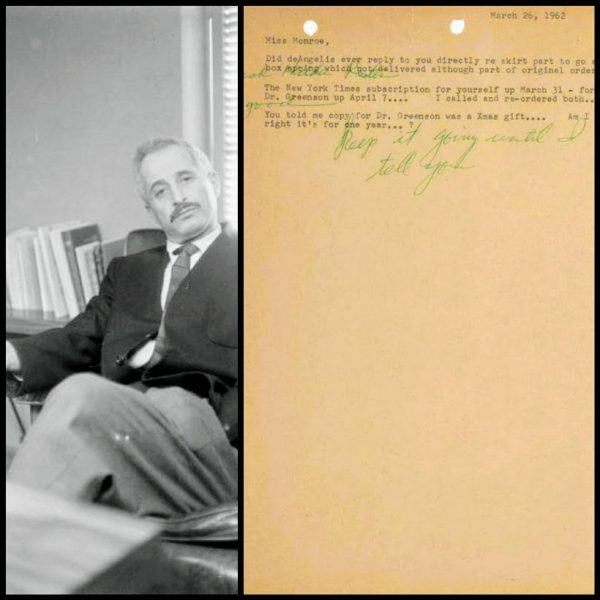
“A single page of beige paper, two-hole punch marks on top margin, dated March 26, 1962, typed text to Monroe from a secretary, the star’s green ballpoint ink responses reading in full ‘ask Hedda Rosten / good / keep it going until I / tell you’ (in reference to paying for Dr. Ralph Greenson‘s New York Times subscription).”
SOLD for $1,280

“A one-page typed letter to Marilyn Monroe from Frederick Vanderbilt Field, dated July 31, 1962, in which Field thanks Monroe for allowing him and his wife Nieves to stay in Monroe’s New York apartment. The letter reads in part, ‘It is quite impossible to thank you enough for your wonderful hospitality to us during our recent visit to New York. The apartment was the key to the success of the whole expedition. It is an extraordinarily attractive place, which is not altogether surprising considering who owns it. But beyond that your instructions to Hedda [Rosten] and Hattie [Stephenson] went far beyond the call of hospitality.’ The letter closes, ‘Nieves asks me to send you her love and to remind you that we both hope you will soon come down for another visit. She also wants you to know that we hope you are winning your battles in Hollywood. We kind of figure that being who and what you are you will come out on top.’ The letter is signed ‘Fred’ in his own hand. Monroe visited the Fields in February that same year during her travel to Mexico. The couple served as tour guides as Monroe shopped for furnishings for her new home in Brentwood, California. Frederick Field was widely believed to be a member of the communist party, and the FBI monitored Monroe during her trip. Sadly, Monroe would pass away just days after this letter was written.”
SOLD for $384
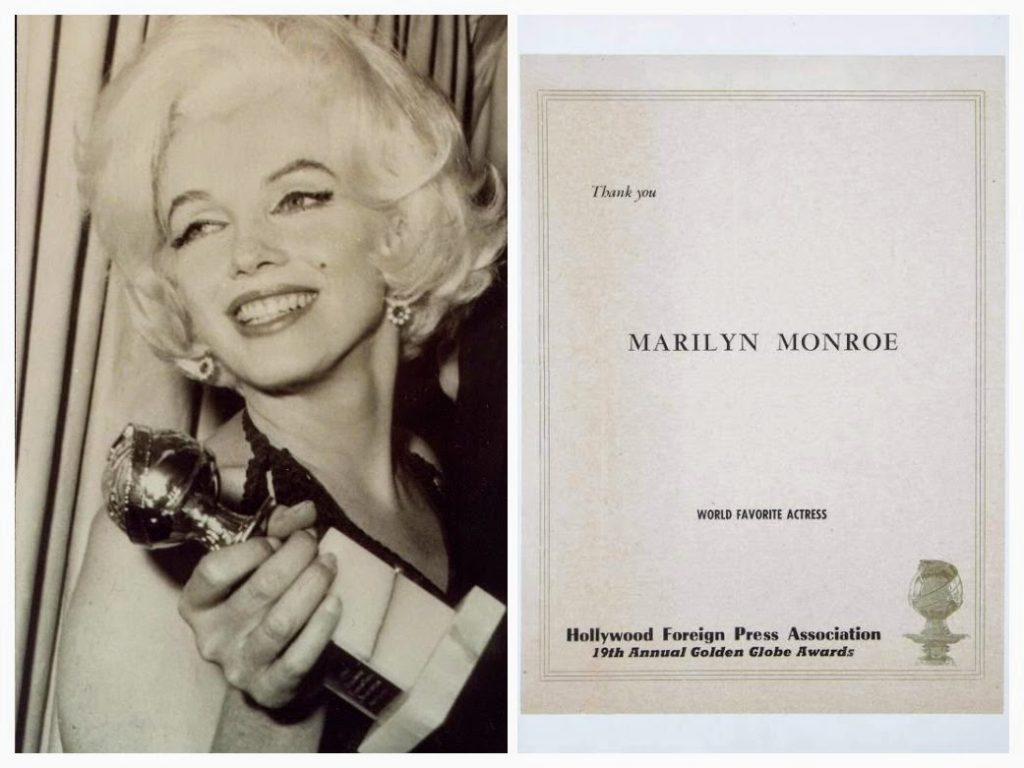
Another selection of items featured in Property From the Life and Career of Marilyn Monroe, going under the hammer at Julien’s Auctions on Thursday, November 1. (You can read all my posts on the sale here.)
“A single page removed from a trade publication such as Variety or The Hollywood Reporter with text reading in part ‘Thank you / Marilyn Monroe’ — an ad the star placed in the publication to thank the Hollywood Foreign Press Association for her 1962 Golden Globe win for ‘World Favorite Actress,’ mounted to cardboard; found in Monroe’s own files. ”
SOLD for $512

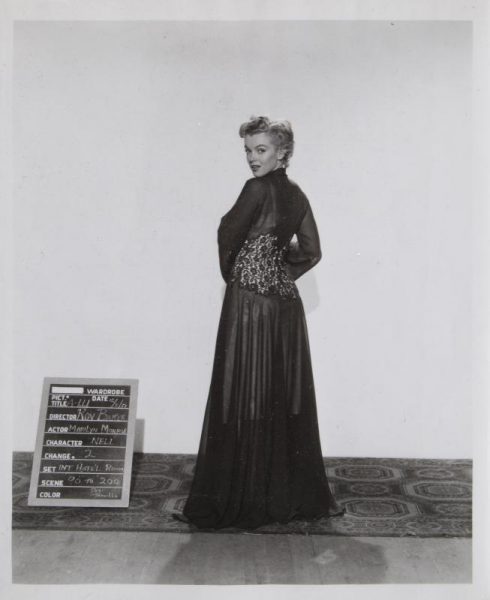
A framed still photo showing Marilyn with co-stars June Haver, William Lundigan and Jack Paar in Love Nest (1951); and a costume test shot for Don’t Bother to Knock (1952.)
Photo sets SOLD for $640 and $896, respectively

Marilyn and Jane Russell performing ‘Two Little Girls From Little Rock’ in Gentlemen Prefer Blondes, as seen on the cover of LIFE magazine in 1953. Marilyn’s costume is expected to fetch a maximum $80,000 – see here.)
Magazine SOLD for $896; costume SOLD for $250,000

A still photo of Marilyn during filming of River of No Return in 1953. The gown she wore while performing the theme song is expected to fetch a maximum $80,000 – see here.
Photo set SOLD for $1,152; costume SOLD for $175,000
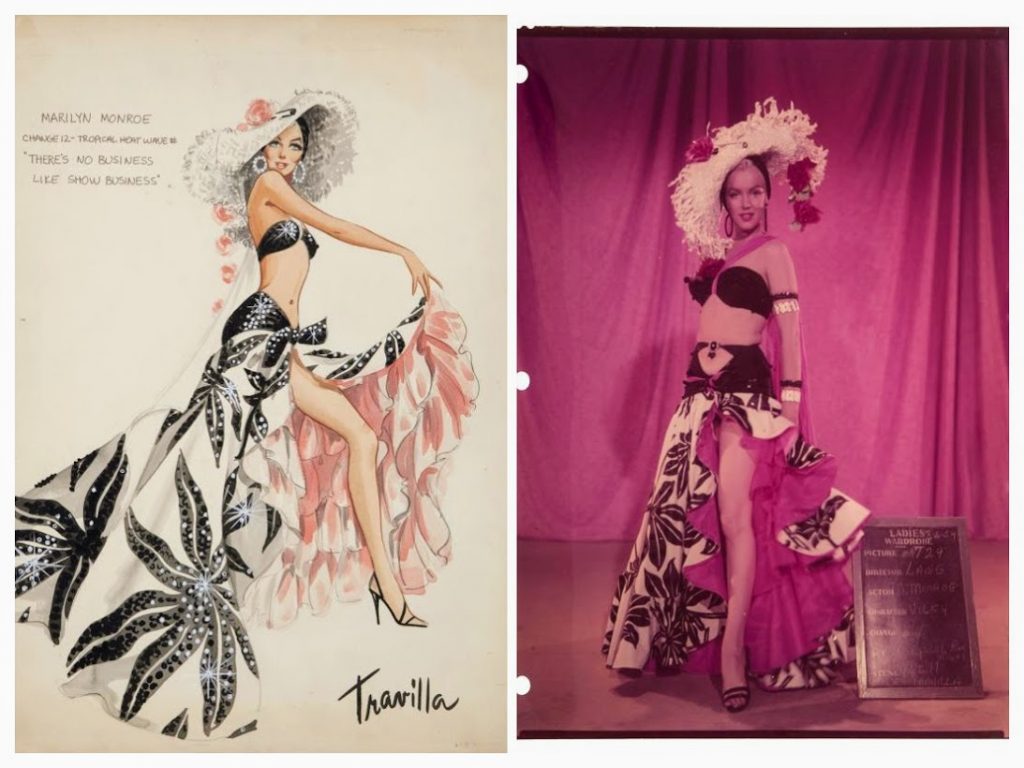
Travilla’s costume sketch for the ‘Heat Wave’ number in There’s No Business Like Show Business (1954), and a colour transparency of Marilyn in costume for a wardrobe test shot. (The costume itself is estimated to fetch up to $80,000 – see here.)
Sketch SOLD for $11,520; photo SOLD for $750; costume SOLD for $280,000

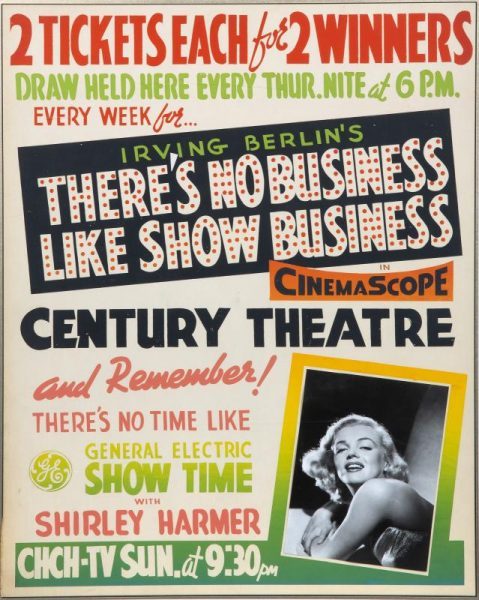
A framed still photo of Marilyn performing ‘Heat Wave‘, and a custom-made, one-of-a-kind poster made for the Century Theatre in the Hamilton, Ontario area to advertise a raffle to win tickets to see There’s No Show Business Like Show Business.
Photo SOLD for $750; poster SOLD for $1,280
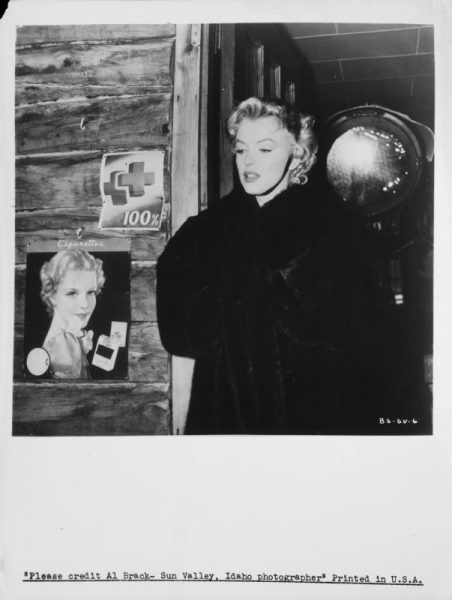
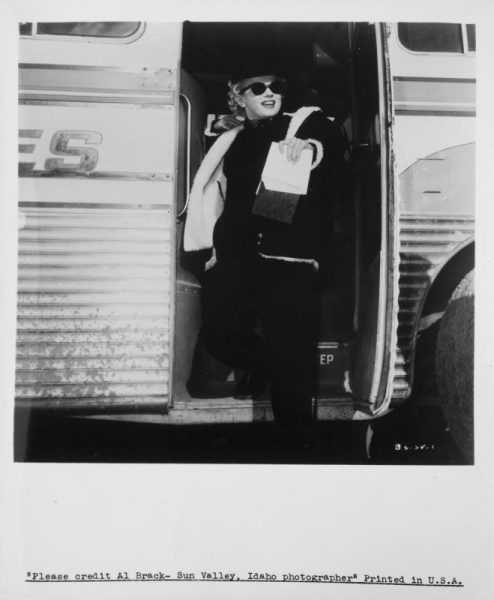

“A group of three, all original prints with a glossy finish, depicting the star behind-the-scenes on the set of her 1956 20th Century Fox film, Bus Stop; all have typed text on the bottom margin noting to credit Al Brack who was a ‘Sun Valley, Idaho photographer.'”
SOLD for $576

A pair of memos regarding Milton Greene’s photos from the set of The Prince and the Showgirl; and, sold separately, a contact sheet. The second memo reads in part, ‘Dear Mike, The print you sent me, that Marilyn Monroe said she had killed, is incorrectly numbered. Marilyn is right – she did kill it.’ Both memos are dated April 11, 1957, and are addressed to ‘Meyer Hunter.’ Lois Weber, one of Monroe’s publicists at the time, authored both memos.”
Memos SOLD for $312.50; contact sheet SOLD for $500
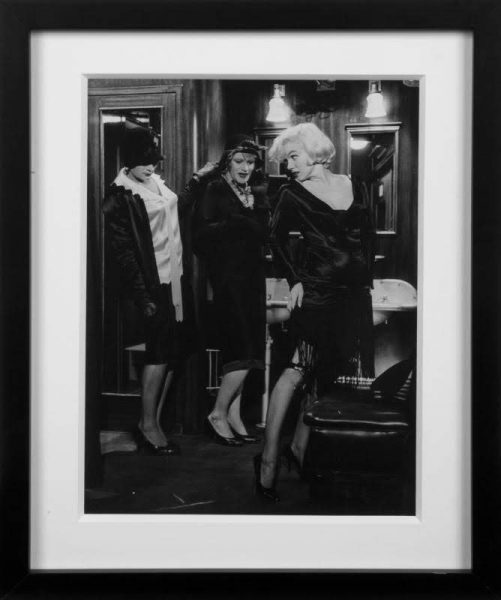
Still photo of Marilyn with co-stars Tony Curtis and Jack Lemmon in a scene from Some Like It Hot (1959.)
Photo set SOLD for $576
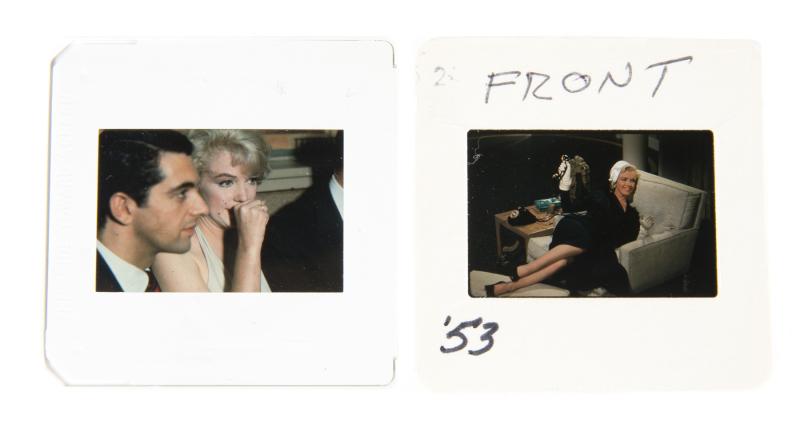
“A pair of colour slides of Marilyn Monroe in a scene from How To Marry a Millionaire (1953), and during a press conference for Let’s Make Love with co-star Frankie Vaughan on January 16, 1960.”
SOLD for $512


Still photos of Marilyn performing ‘My Heart Belongs to Daddy‘, and with director George Cukor, both taken on the set of Let’s Make Love.
SOLD for $512 and $640, respectively
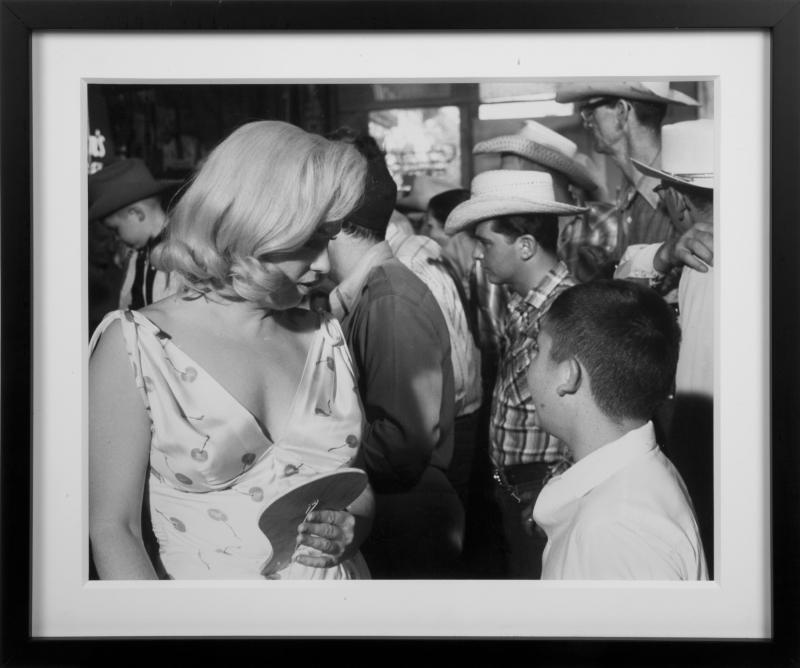
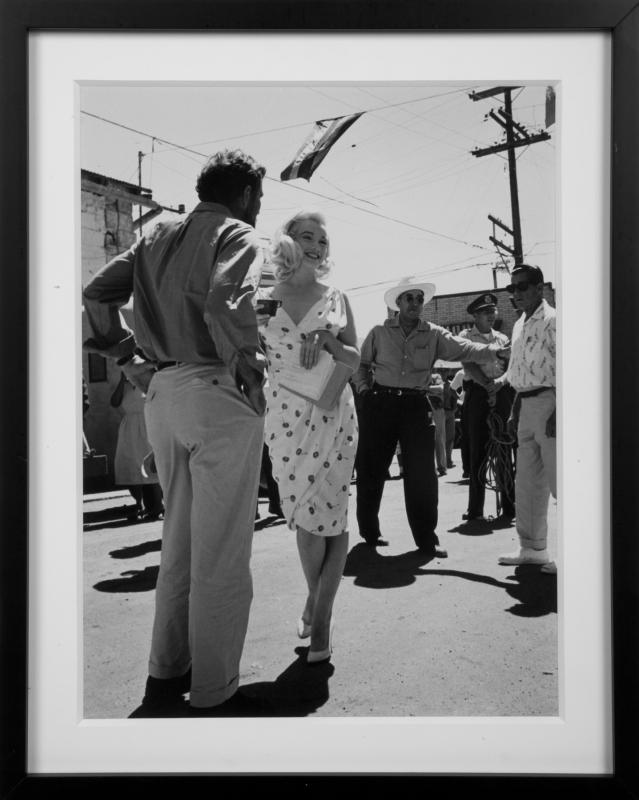
Candid photos taken during filming of The Misfits in 1960.
Photo sets sold for $1,562.50 and $1, 920, respectively
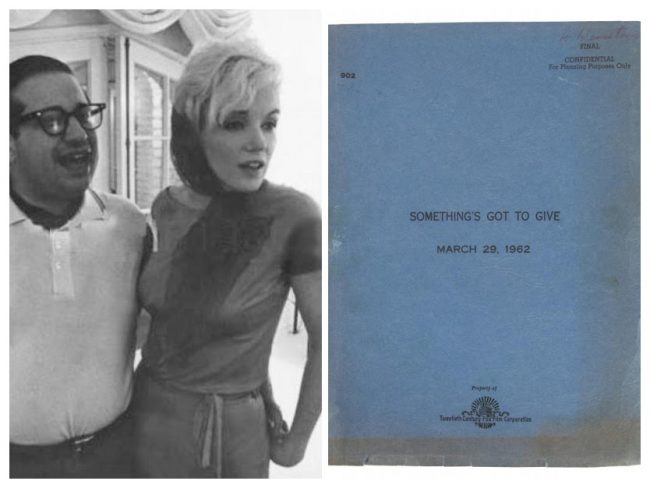
Producer Henry Weinstein’s screenplay for the unfinished Something’s Got to Give (1962.)
SOLD for $768

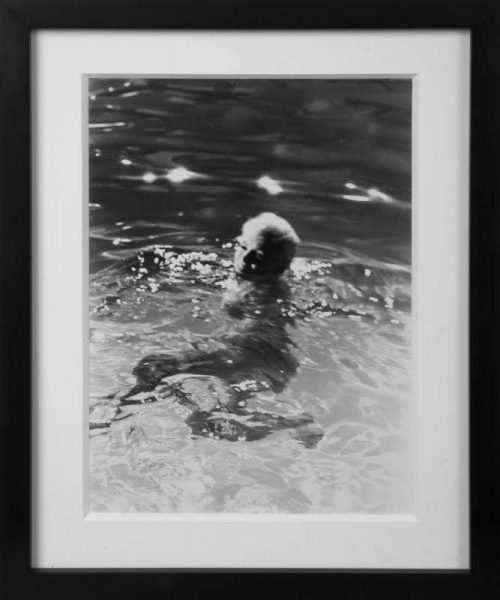

Still photos taken by Lawrence Schiller during filming of the ‘pool scene’ in Something’s Got to Give.
Photo sets sold for $1,280 each
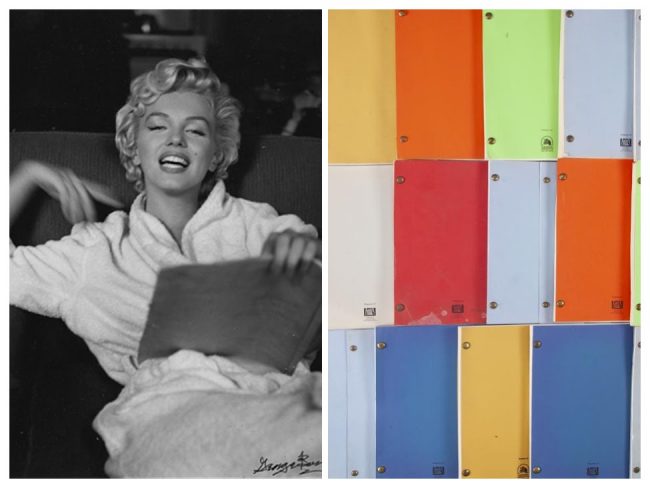
“A collection of approximately 65 pieces comprising only photocopied scripts and documents, all related to Marilyn Monroe’s films. Some film titles have more than one copy of the script, and some feature the working title and not the final one. All are bound into 20th Century Fox covers of various colors and appear to be the studio’s ‘loan out’ or ‘library’ copies. Pieces include (in alphabetical order): All About Eve (a treatment only), As Young As You Feel (2 scripts ), Bus Stop (3 scripts), Dangerous Years (1 script), Don’t Bother to Knock (2 scripts), The Full House (1 script), Gentlemen Prefer Blondes (2 scripts plus 4 related documents), How to Marry a Millionaire (3 scripts plus 1 related document), Let’s Make Love (2 scripts), Love Nest (2 scripts), Monkey Business (2 scripts plus 2 related documents), Move Over, Darling (1 script), Niagara (2 scripts plus 4 related documents), O. Henry’s Full House (2 scripts plus 1 related document), River of No Return (1 script plus 5 related documents), The Seven Year Itch (3 scripts), Something’s Got to Give (1 script), There’s No Business Like Show Business (3 scripts plus 7 related documents), Ticket to Tomahawk (2 related documents), and We’re Not Married (1 script plus 1 related document). Also included are a few miscellaneous pieces related to Monroe. “
SOLD for $896
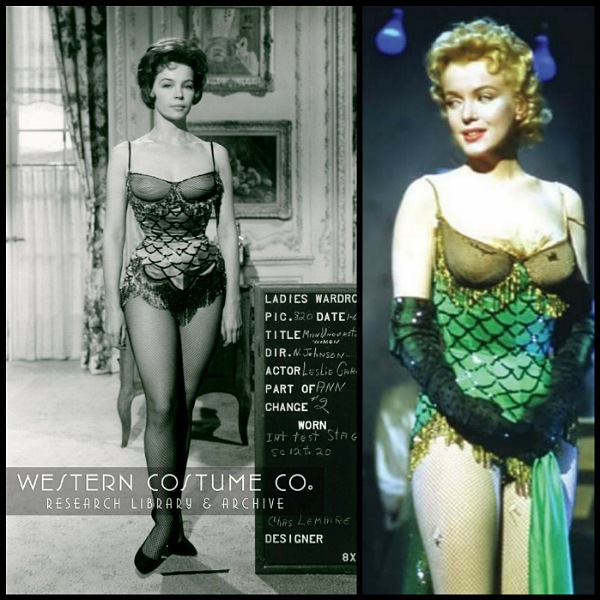
As was common practice in old Hollywood, several of Marilyn’s movie gowns were repurposed for other actresses; and earlier in her career, she had often worn gowns borrowed from the studio’s wardrobe department to glitzy public events. Here we see Leslie Caron wearing an adjusted variant based on Marilyn’s tutu – or ‘snake costume’ – from Bus Stop (1956) in The Man Who Understand Women, which as the Western Costume Company notes, was released sixty years ago, on this day in 1959. Written by Nunnally Johnson (How to Marry a Millionaire), this romantic comedy also starred Henry Fonda. And although Charles Le Maire (All About Eve) was credited as costume designer, this tutu had been created for Marilyn by Travilla.